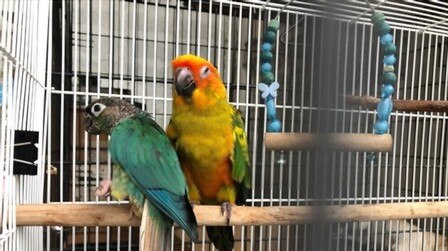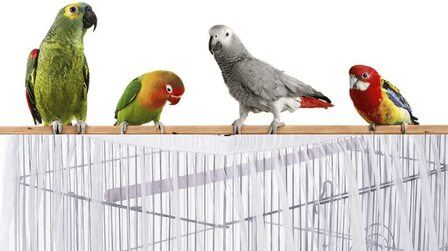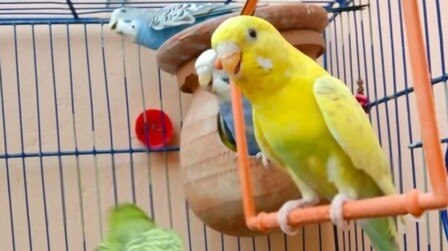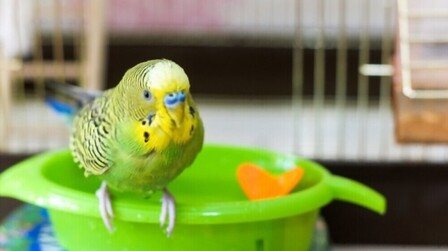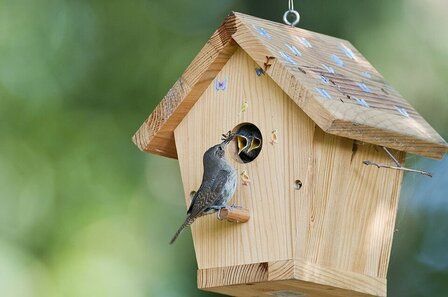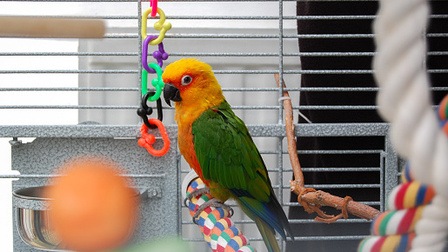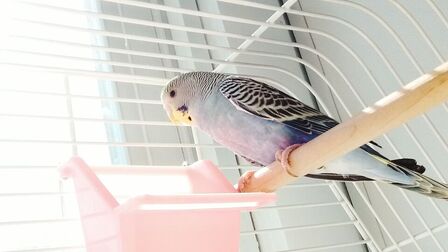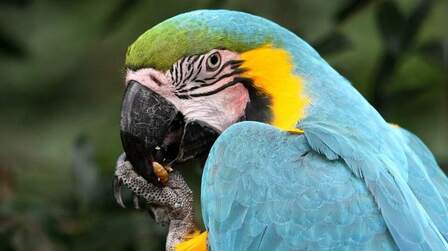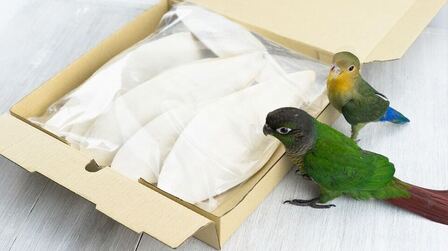If you observe that the parrot's plumage is dull and a bit brittle, or your bird seems gloomy and lethargic. It is one of the characteristics of the lack of light provided.
The lack of suitable spectral light is also considered a rather significant problem. Birds that are exposed to natural sunlight outdoors or indoor bird lights have improved feather and skin conditions, happier attitudes, and healthier bones.
Just like us, Vitamin D keeps your immune system strong and helps regulate insulin levels. It is also important for calcium and phosphorus absorption. So let's take a closer look at the benefits of light for birds.
1. Benefits of light for birds
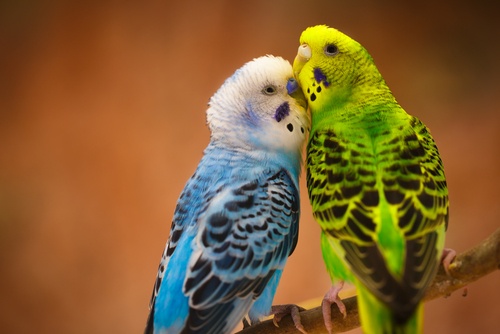
If you provide enough spectrum light to birds, it affects their mental and physical health. Most birds, including parrots, will have particularly keen vision. And your pet is essentially color blind without full-spectrum light. Parrots can see bright colors when moving in the environment, foraging between leaves and branches, and perceiving dangers as predators. When the necessary light is provided, the bird's keen vision improves and the ability to keep himself safe.
Physiologically, spectral light provides Vitamin D3, an essential component in the process of using calcium to help keep bones strong and healthy. With parrot skeletons inherently fragile, light helps keep bones healthy.
In addition, light influences behavior and seasonal hormone levels, allowing birds to get a good night's sleep and even affecting plumage health.
2. How long hours of light do birds need per day?

Parrots can come from anywhere you want like rainforest areas where the sun shines 10 hours a day, or all year round. Sunlight contains both UVA and UVB rays, so it is essential for bird health. You've certainly heard about seasonal depression, but did you know birds are more sensitive to light and light conditions than humans?
3. How long must the bird lights be on?
As mentioned above, sunlight is important for the regulation of bird sleep. Light signals to the brain that it's time to go to sleep or wake up.
Darkness affects sleep quality. As a general rule, birds need about 10 hours of light per day. Without full spectrum light, pets may feel fatigued, and more responsive to stress, and the immune system may be compromised.
Even if you live in a climate where birds don't have access to a natural full-spectrum light, it can help keep your birds healthy with indoor full-spectrum lighting.
4. What are UVA and UVB rays?

UV rays are part of the invisible spectrum of light that the sun emits every day. UVA rays have the longest UV rays and make up 95% of the radiation from the sun.
UVB rays are not as strong as UVA rays and do not penetrate windows or other pieces of glass.
While your birds are outside in the sunlight in a wire cage or garden aviary together, time is limited. Therefore, the need for artificially balanced UV light is essential.
As for indoor and outdoor lights that don't usually emit UVA or UVB rays, birds will certainly not get UV rays when sitting under these lights.
5. Why is vitamin D3 important?

Vitamin D3 is important for all birds and is produced through direct exposure to the sun's UV rays. This leads to the activation of the vitamin in the exposed skin on the prostate (or mammary gland) on the acne.
If you find birds not exposed to UV rays in sunlight, a calcium deficiency will develop.
The vitamin D3 deficiency might cause some symptoms:
Brittle or weak bones
If it's a female, it can lead to a lack of calcium in the eggs, leaving them soft and rubbery in texture.
The higher the risk of the egg sticking, and the bird being unable to push the eggs out of the body. If left untreated, egg binding will be fatal
Calcium deficiency affects muscle contraction, organ and nerve function
As mentioned above, UV improves the psychological health of Parrots. Furthermore, prevents destructive behaviors such as plucking and improves appetite, coat condition, and overall health.
Unlike humans, Parrots can see the entire spectrum of UVA light because of their specialized retinas. This means that without it, they would be color blind.
If viewed under UV light, the color is clearer. Parrots also use a variety of UV-unlocked colors to identify mates, find food, and recognize different species. Their feathers reflect UV light and since plumage is important to birds when choosing a mate, mating will be successful in the presence of UV light.
At the same time, UVB rays play a very important role, allowing your Parrot to synthesize Vitamin D3 either in their skin or through a special process involving the preening glands. Because parrots need Vitamin D3 to metabolize calcium, birds can use it to produce eggs, build and maintain strong bones, and maintain normal growth.
6. How to use bird lights

Specialized bird lights designed to be mounted higher
The bird's head is about 25-38cm (10-15ins) when they are sitting on the perching bird's head.
If installed correctly and at the right distance, birds can experience the energy of the lights as intended, safely and effectively.
Birds are curious feet and minds, so take that into account when installing an effective lighting system.
If your bird often flies or climbs closer than 25cm for a moment. This is a real danger if the bird is kept in a small cage with a lamp installed over the entire area, unable to move away from the light source.
Therefore, if the UV lamp is placed so close that the birds cannot move away, there is a risk of sunburn and eye damage.
But if the light is installed too far away from the birds and birds, it won't help either. The exact location is quite important.
How light can propagate from the source
The total energy of the lamp can be considered as 100% at the source. The farther the light is from the target, the wider the beam means less energy...
The essence of the lamp is a cylinder, emitting light around itself. Up to 60-70% of the energy generated by the lights is going in the wrong direction, away from the bird.
The most important thing is to choose a reflector suitable for use with the light pointing the rays downwards. It will reduce the light spilling into the room.
7. Some practical examples of using bird lights
- Lamp wattage for Budgie: if they are in a wire cage 45cm (18ins) wide, 60cm (24ins) high and 45cm (18ins) deep can supply an 8-watt bulb 30cm (12ins) long. It will help illuminate the full width of the cage but will provide shade towards the bottom.
- Parakeets: they will share one or two large macaws in a 1.8m (6ft) high and wide cage that will use a T5 54W 1.2m (4ft) linear light.
- African Gray: cage 0.9m (3ft) wide and 1.2m (4ft) high using compact E27 lamp or 24W compact lamp (ParrotPro). Both will deliver well and allow for natural self-regulation.
- Lovebird: wire cages or wooden cabinets will typically glue an 8W spawn kit to the front of each cage, or a 54W 1.2m (4ft) kit along with the duo or triple.
But if installed at the top of the cage, on the outside cord, will provide energy use in the front top half of the cage with a shady area towards the back and bottom.
8. Types of light lamps for birds

High power T5 or HO-T5
Represent new technology today. The T5 light is 16mm (5/8 inch) in diameter, thin, and easy to conceal. Usually available in standard output and high output form.
The HO-T5 will be flicker-free and produce nearly twice as much light per watt usage as the T8, with more photons per watt and greater UV reach. Brighter and more powerful, perfect for large cage use.
HO-T5 linear bird light is optional 54W 117cm (46ins).
The high output T5 compact lamp uses the same technology built into the T5 but is in a short format and has two tubes fitted into the lamp holder side by side.
They give off sharp, bright light and are fitted to a 'flood' reflector.
Standard
- Standard T8 or SO-T8: low power linear light 1in (2.5cm) in diameter, with slow flicker rate when used with magnetic ballast. It is suitable for mounting on flights or fixed to the banks of small cages, providing effective and soft light.
- Standard T5 or SO-T5: thinner than this, measuring just 16mm (5/8 inch) in diameter, using only 8W of power, and 30cm (12in) long. It includes a 30cm (12ins) breeding kit and easily fits into cages for small species.
- E27 Compact: is a flicker-free screw-down light with an internal digital ballast. They are designed to fit over the cage.
Recently, it has completely upgraded its design and uses a '3 linear ring' glass profile to increase the glass area.
- Zoology: are multi-lamp accessories using the lights above, arranged in groups for large freestyle flights or caged in a zoology collection.
Conclusion
Over the above, we have shared the benefits of light for birds to help improve the bird's surroundings making them look more natural. Nowadays, many manufacturers also offer LED lights and develop a light with beneficial wavelengths that best suit the bird's requirements.

